We may not have the course you’re looking for. If you enquire or give us a call on + 1-866 272 8822 and speak to our training experts, we may still be able to help with your training requirements.
Training Outcomes Within Your Budget!
We ensure quality, budget-alignment, and timely delivery by our expert instructors.
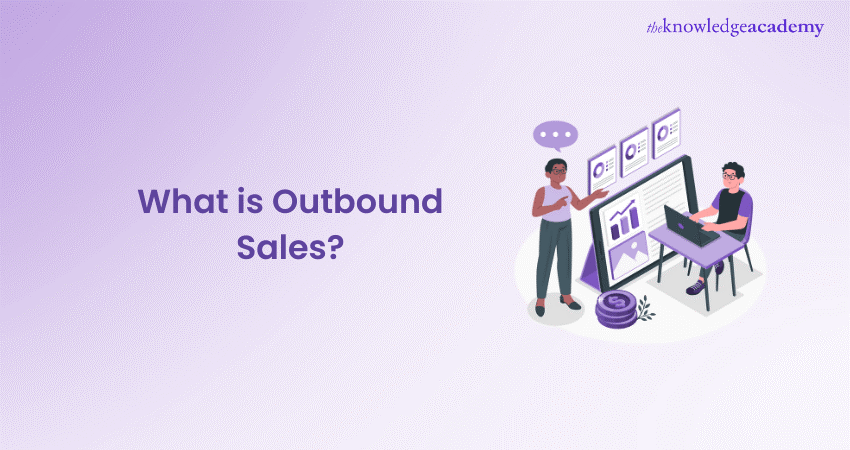
Think of Outbound Sales like a game of chess where you make the first move in the fast-paced world of sales. Unlike its inbound counterpart, where you wait for customers to contact you, Outbound Sales are all about stepping up, reaching out, and grabbing opportunities by the horns. Outbound Sales contribute to most of the revenue for B2B companies, proving its effectiveness as a key driver of business growth.
But what exactly is Outbound Sales, and how does it supercharge your sales strategy? In this detailed blog, we’ll unravel the secret behind successful sales, giving you the full picture and some insider tips to elevate your game. So, dive in and make your move!
Table of Contents
1) What is Outbound Sales?
2) Different Types of Outbound Sales Reps
3) The 5 Step Outbound Sales Process
4) Effective Outbound Sales Strategies to Boost Your Success
5) Benefits of Outbound Sales
6) Examples of Outbound Sales
7) Conclusion
What is Outbound Sales?
Outbound Sales involve proactively contacting potential buyers through phone, email, social media, or other channels. The main purpose of Outbound Sales is to contact people and generate sales instead of waiting for them to act. This differs from inbound sales, where the potential buyer starts the conversation (e.g., filling out a demo request form).
Outbound Sales sometimes include cold-calling leads on a list. Reps often call leads that have previously demonstrated demand by engaging with a brand’s content, emailing a business, registering for an event, or making a previous call.
Different Types of Outbound Sales Reps
Outbound Sales reps fall into two categories: Sales development representatives and lead response representatives. They each serve distinct purposes to contribute to the overarching business goal as explained below:
Sales Development Representatives
Sales development reps are tasked with outbound prospecting and are frequently given a list of leads to call. While they sometimes cold-call these leads, they often contact via email or social media first to make a connection. Rather than closing deals, these reps are tasked with creating opportunities for Account Executives (also called salespeople).
This saves top closers the trouble of prospecting for their leads. Account Executives can maximise the revenue they close per quarter by only selling to qualified sales leads.
Lead Response Representatives
Lead response reps are vital in creating opportunities for Account Executives. They often make outbound calls to leads who have demonstrated demand by filling out a form, attending a webinar, reading a blog or downloading a video.
Their task of following up with inbound leads is vital, as much of what lead response reps do is making Outbound Sales calls in response to buyer engagement. Like their sales development counterpart, they oversee the creation of opportunities for Account Executives.
Boost your career with top-tier Sales Training! Learn powerful strategies to drive growth and maximize profits. Start now!
The 5 Step Outbound Sales Process
A successful Outbound Sales strategy requires a systematic and efficient approach, from fixing your target audience to closing a deal. The following curated list of the 5-step Outbound Sales process will help you get started:
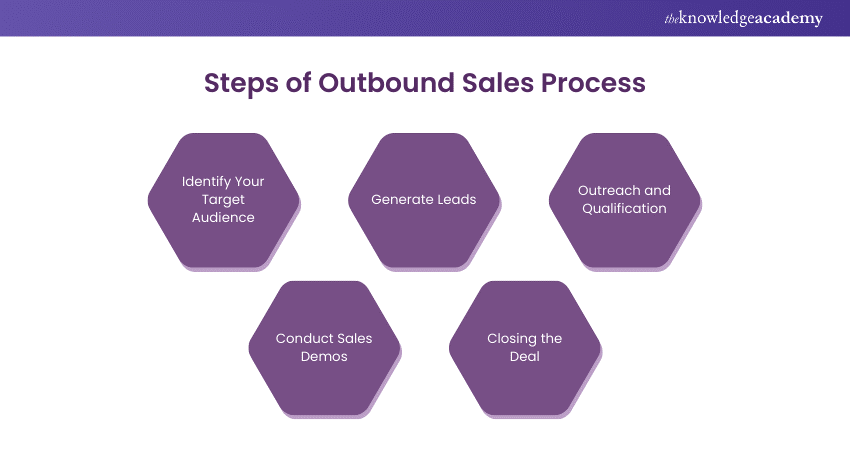
1) Identify Your Target Audience
The first step of the Outbound Sales process is determining who you will be selling to. This involves defining your Ideal Customer Profile (ICP) and creating a buyer's persona. An ICP describes the type of business that’s most likely to benefit from your product. It goes beyond basic demographics and includes factors like business goals, company size, industry, budget, and pain points.
On the other hand, a buyer persona is a fictional representation of your ICP companies’ key decision-maker. It’s based on details, such as their job titles, goals, challenges, buying habits, and preferences.
You can follow the following steps to create your ICP:
a) Look at your existing customers and evaluate them based on average deal size, success potential, customer lifetime value, etc.
b) Based on your findings, you must list your top 10 existing customers and identify similar attributes.
c) Leverage these attributes to define your Ideal Customer Profile.
As for developing the buyer persona, follow these steps:
a) Once you've created your ICP, identify commonalities between the decision-makers of your top customers.
b) Gather their demographics, seniority, job role, goals, and pain points.
c) Use common attributes to create a fictional representation of your target customer.
d) If there are multiple decision-makers, you must create different buyer personas for all.
2) Generate Leads
A lead is someone who can be a good fit for product purchase. Once you've figured out which potential customers you want to reach out to, it's crucial to gather their details and contact information. This step is essential in assembling your pipeline and moving towards successful sales.
There are a couple of ways you can do this:
a) You can do it the old-fashioned way by manually creating a list using tools like social media platforms, LinkedIn, or web directories.
b) To make things easier, you can use a prospecting tool to automate the process.
c) If you're not keen on doing it yourself, you can hire a lead gen agency to find the right prospects.
3) Outreach and Qualification
Once your pipeline is ready, the next step involves determining qualified leads who meet all predefined criteria and have a higher chance of converting into customers. Most Outbound Sales reps use cold-calling and emailing to qualify leads. This helps them introduce their product, gauge the prospect's interest, and gather relevant information to qualify them as viable leads.
You can also use lead qualification frameworks such as:
a) Metrics, Economic Buyer, Decision Criteria, Decision Process, Identify Pain, and Champion: Also known as MEDDIC, this approach enables sales reps to qualify leads based on various factors. These factors include measurable metrics, the presence of an economic buyer with purchasing authority, their decision-making criteria, their pain points, and an internal champion who supports the purchase decision.
b) Budget, Authority, Need, and Timing: Also known as BANT, this approach evaluates a prospect's financial capacity, decision-making authority, pain points, and timeline for purchasing.
c) Authority, Need, Urgency, and Money (ANUM): This approach is similar to BANT but emphasises authority. ANUM helps determine if the lead has decision-making authority, a genuine need for the product, a sense of urgency to address their needs, and the financial resources to purchase.
4) Conduct Sales Demos
Once an SDR qualifies a lead and successfully schedules a meeting, the prospect is handed off to the account executive (AE). The AE conducts a demo of the product or service, showcasing its features, benefits, and value proposition. During this demo, the AE addresses the prospect's pain points, outlining how the solution can effectively resolve their challenges.
5) Closing the Deal
This is the moment you've been working towards, where all your efforts and strategies converge to finalise the deal. After delivering a compelling demo, the next step is to negotiate and agree on a price both parties can agree on. The deal is officially closed when the terms are finalised and the prospect signs the contract.
Looking to transition from in-person to online selling? Our Remote Selling Courses will guide you - Sign up now!
Effective Outbound Sales Strategies to Boost Your Success
Outbound Sales are effective, but sales reps still face challenges. Dealing with client rejections and having super high targets can make closing deals feel like an uphill battle. But with the following five tips for Outbound Sales, you can strengthen your pitch and close more deals quickly:
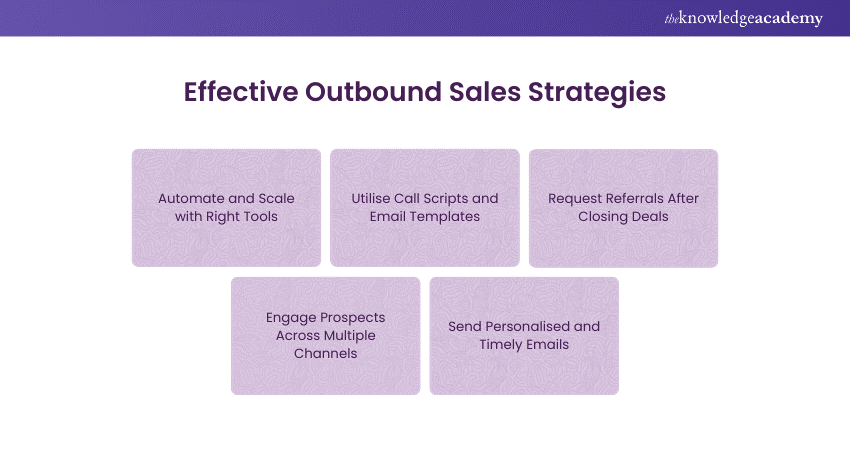
1) Automate and Scale with the Right Tools
The best Outbound Sales software can help you boost efficiency and productivity while reaching a larger audience. They allow you to save time and effort by eliminating all boring manual tasks such as data entry, follow-ups, and scheduling. Additionally, with Outbound Sales software, you can keep your brand messaging consistent, monitor client interactions, and use analytics to see how effective your outreach is.
Depending on your problem areas, you can choose from various tools. Here are some Outbound Sales automation software used by companies:
a) Customer relationship management (CRM) system
b) Sales reporting/analytics
c) Mobile sales app(s) for employees
d) Account and contact management
e) Sales forecasting tools
2) Utilise Call Scripts and Email Templates
Having sales email templates and cold calling scripts handy can help you navigate prospect communications seamlessly. It's like having a cheat sheet to ensure you always say the right things, keep the conversation flowing smoothly, and get things done faster. Additionally, they help you quickly address potential concerns and objections of the prospect.
However, it's important not to sound like a telemarketer reading off a script during the call. Personalising your cold call script is a way to show your prospects that you value their individuality and are not just following a generic sales pitch.
3) Request Referrals After Closing Deals
After closing a deal, your relationship with the prospect is still ongoing. You can make the most of their positive experience by requesting a referral. But remember, timing is critical. When you request for referrals immediately after closing the deal, your customers are still riding high on that positive experience and are more likely to be open to your request. So, you must approach them with gratitude for their business and tell them you're eager to help others with similar needs.
4) Engage Prospects Across Multiple Channels
It's crucial not to limit your prospecting efforts to just phone calls and emails. Exploring other communication channels can provide you with more flexibility and increase your chances of capturing your prospects' attention.
One platform that can supercharge your prospecting ambitions is LinkedIn. With over a billion users worldwide, this professional networking site lets you dig deep into user profiles to understand more about our prospects. While platforms like X (formerly Twitter) may not sound business-oriented, their open natures give them immense potential in Outbound Sales strategy.
5) Send Personalised and Timely Emails
How do you stand out when your prospect's inboxes are flooded with generic and impersonal emails trying to sell them the next best thing? This is where personalisation differentiates a cold email from junk mail. Half of decision-makers tend to ignore companies' non-personalised communications.
So, incorporate relevant details like the company, industry, your prospect's name, or previous interactions to show you have done your research and are genuinely interested in addressing their pain points.
But what is even more critical is timing your cold emails for higher responses and open rates. According to most experts, the best time to send a cold email is between 7 and 8 am, 11 am and 12 pm, and 1 to 4 pm.
Want to learn how to measure, manage, and analyse sales performance? Sign up for our Sales Analytics Training now!
Benefits of Outbound Sales
Outbound selling provides several advantages, particularly for businesses targeting specific markets, generating qualified leads, and getting regular customer feedback. Here are the key benefits:
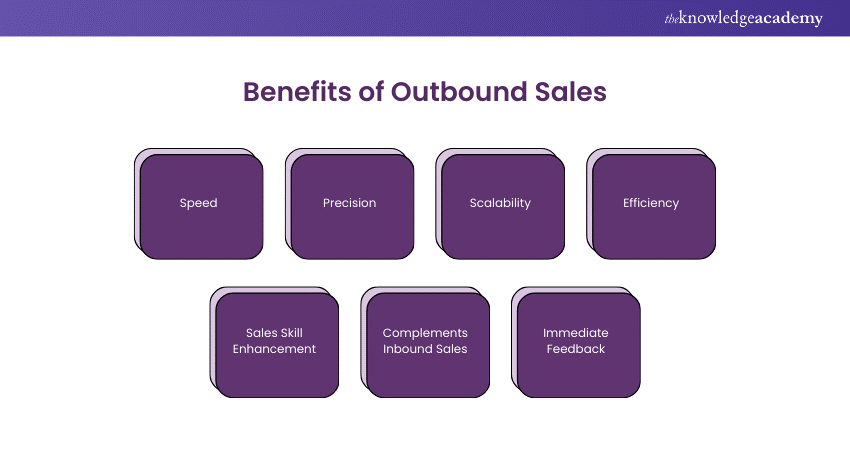
1) Speed
Unlike inbound sales, Outbound Sales can produce immediate leads and sales because sales teams can target prospects who match ideal customer profiles, leading to high-quality leads.
2) Precision
Outbound Sales allow businesses to precisely target specific industries, company sizes, or decision-makers. Sales reps can tailor their messaging based on each prospect’s needs and pain points.
3) Scalability
Outbound Sales efforts can be scaled quickly by hiring additional business development representatives and expanding outreach campaigns. Furthermore, by documenting and replicating successful Outbound Sales processes, it becomes easier to train new sales team members and ensure consistency across the board.
4) Efficiency
Outbound Sales focus on high-value warm leads, ensuring that sales resources are spent on only the most promising prospects. By maintaining consistent outbound activities, businesses can develop a more manageable (and predictable) sales pipeline.
5) Sales Skill Enhancement
Outbound Sales reps can enhance their skills and approach through repeated interactions with potential customers. Outbound Sales agents become proficient at overcoming resistance and handling objections. These are valuable skills in any business context.
6) Complements Inbound Sales
Outbound Sales can complement inbound strategies by reaching out to leads who may not have engaged with inbound content. This integrated approach ensures no potential leads are missed. Outbound Sales can re-engage dormant or inactive leads who may have shown interest in the past but have yet to convert.
7) Immediate Feedback
Direct interaction with B2B buyers offers immediate feedback on their objections, needs, and overall interest, enabling Outbound Sales reps to adjust their strategy quickly. Meaningful conversations with prospects can reveal valuable information about competitor activities, market trends, and customer preferences.
Want to learn how build trust with your potential customer via telephone? Sign up for our Telephone Sales Training now!
Examples of Outbound Sales
The most popular examples of Outbound Sales include the following:
1) Cold Calling: This is the technique where sales reps make unsolicited phone calls to potential customers with the aim of garnering interest their interest in a service or product.
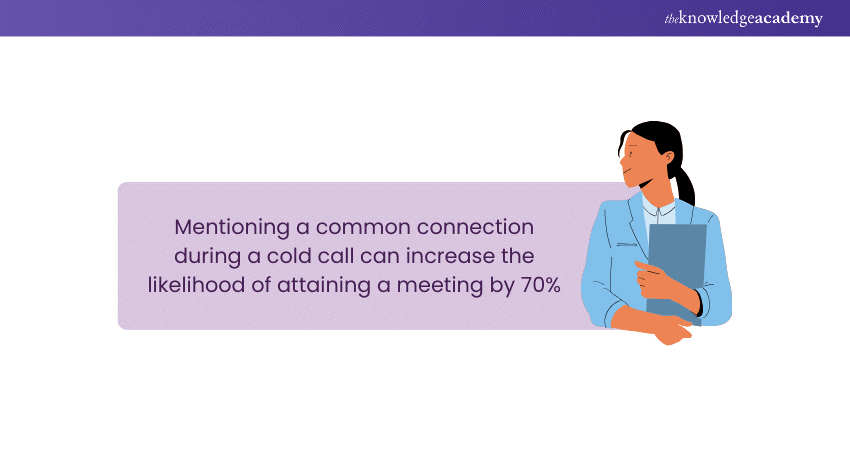
2) Email Outreach: Sending personalised emails to potential customers with the purpose of introducing a product, service, or special offer is a time-tested strategy. This helps in initiating a conversation or setting up a meeting.
3) LinkedIn Messaging: A common example of Outbound Sales is reaching out to potential customers via LinkedIn. This enables businesses to establish a connection and introduce their offerings.
4) Direct Mail Campaigns: In this approach, physical marketing materials including brochures, postcards, or samples, are directly sent to potential customers by sales reps to gain their interest.
5) Telemarketing: Another good technique is the use of scripts to make phone calls to a broad audience, aiming promote products and services, and gather leads.

6) Event or Trade Show Outreach: In this powerful approach, sales reps reach out to potential customers before, during, or after industry events. This is done to introduce products or services or even schedule meetings.
7) Social Media Outreach: This is among the most popular strategies and involves engaging with potential customers on Social Media platforms. Sales rep send direct messages, comment on the prospects’ posts, or share content that sways conversations towards products or services. This strategy shows the most promise since most of the prospects are on social media nowadays.
Conclusion
Outbound Sales is an approach where sales representatives proactively reach out to potential customers, helping to build relationships and drive new leads. It's a multi-faceted strategy for companies aiming to scale and thrive in today's dynamic market. Equipped with these key strategies and tools, you’ll be able to effectively grow your client base, boost revenue, and stay ahead of the competition.
Want to learn about negotiation techniques to maximise your sales potential? Sign up for our Sales Negotiation Training – Sign up now!
Frequently Asked Questions

Outbound Sales jobs refer to jobs where sales representatives reach out to potential customers using various channels, including phone, email and social media.

Inbound sales involve customers contacting your business for product or service queries. On the other hand, Outbound Sales occur when sales reps actively approach potential customers who have yet to express interest in any product or service.

The Knowledge Academy takes global learning to new heights, offering over 30,000 online courses across 490+ locations in 220 countries. This expansive reach ensures accessibility and convenience for learners worldwide.
Alongside our diverse Online Course Catalogue, encompassing 19 major categories, we go the extra mile by providing a plethora of free educational Online Resources like News updates, Blogs, videos, webinars, and interview questions. Tailoring learning experiences further, professionals can maximise value with customisable Course Bundles of TKA.

The Knowledge Academy’s Knowledge Pass, a prepaid voucher, adds another layer of flexibility, allowing course bookings over a 12-month period. Join us on a journey where education knows no bounds.

The Knowledge Academy offers various Sales Courses, including the Sales Negotiation Course and the Sales Analytics Course. These courses cater to different skill levels, providing comprehensive insights into Sales Process.
Our Business Skills Blogs cover a range of topics related to Sales, offering valuable resources, best practices, and industry insights. Whether you are a beginner or looking to advance your Sales Skills, The Knowledge Academy's diverse courses and informative blogs have got you covered.
Upcoming Business Skills Resources Batches & Dates
Date
 Sales Bootcamp
Sales Bootcamp
Fri 17th Jan 2025
Fri 21st Feb 2025
Fri 4th Apr 2025
Fri 6th Jun 2025
Fri 29th Aug 2025
Fri 24th Oct 2025
Fri 26th Dec 2025







 Top Rated Course
Top Rated Course



 If you wish to make any changes to your course, please
If you wish to make any changes to your course, please


